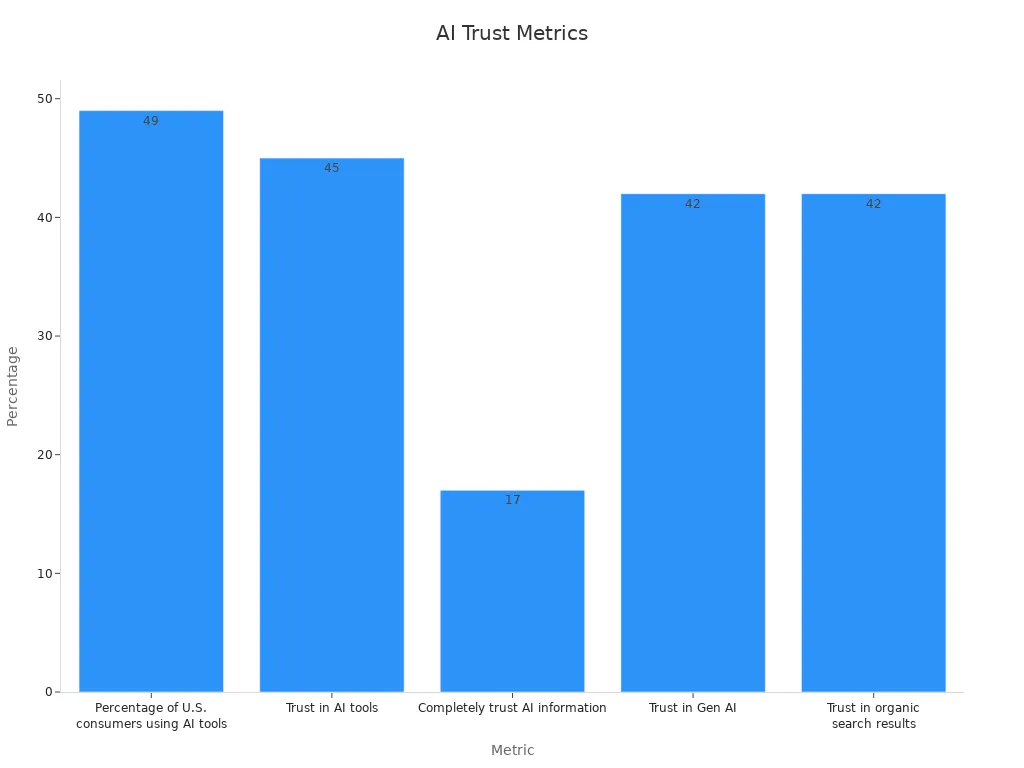Using AI to Build Trust with New Audiences

In today’s online world, trust is very important. People quickly lose trust in brands after a data breach. Almost half of them stop interacting with those brands. Many families worry about staying safe online. About three out of four households feel this way. This is where using AI can help. It lets you connect with people using personal experiences and clear messages. It also supports fair and honest actions. When you focus on being open and keeping data safe, you do more than protect people. You create strong relationships they can count on.
Key Takeaways
Trust is very important online. Companies need to be honest and clear about what they do.
AI can make things more personal, creating unique experiences. This helps people stay loyal and interested.
Explainable AI shows how AI makes choices. Being clear builds trust and responsibility.
Using AI fairly is very important. Companies should treat everyone equally, keep data safe, and share how AI is used.
Check and update AI often. This keeps trust strong and makes sure it works well.
Understanding Trust in the Age of AI
What trust means for online users.
Trust online means believing a brand will do what’s right. It’s about feeling sure your data is safe and info is true. But trust doesn’t happen instantly—it must be earned. For example, almost 90% of people want to know if AI made an image. This shows how much honesty matters in online spaces. Being clear about your actions helps build trust.
Why being open and real matters.
Being open and real helps keep trust strong. When brands share honestly, they connect better with people. For example, Patagonia shares details about their products and eco-impact. This makes them popular with shoppers who care about the planet. In fact, 63% of people like buying from green companies. Being real also matters. Sharing true stories that match your values makes your brand feel honest and relatable.
Proof Type | What It Shows |
|---|---|
Open Communication | Being open builds loyalty and trust. |
Real Storytelling | True stories make people trust and like your brand. |
Patagonia Example | Sharing openly helped Patagonia grow sales by 30% in 2020. |
How AI can help or hurt trust.
AI can build or break trust based on how it’s used. Good AI tools that work well make people feel confident. For example, AI that suggests helpful products feels personal. But unfair or biased AI can harm trust. Explaining how AI works is very important. When people understand AI decisions, they trust them more.

By focusing on fairness, accuracy, and honesty, AI can help you connect with people in meaningful ways.
Using AI to Personalize and Enhance Audience Experiences

Personalization: Making experiences feel special.
Have you ever noticed how a website seems to know your likes? That’s called personalization. AI helps businesses create experiences just for you. It looks at your choices, past actions, and even where you are. Then, it suggests products, services, or content you might enjoy. For example, Spotify uses your listening habits to make playlists like Discover Weekly. This has helped Spotify keep over 400 million users engaged.
Personalization isn’t just helpful—it builds trust. When you feel understood, you want to stay. Starbucks uses customer data to greet you by name. It also suggests drinks based on what you’ve ordered before. These small details make the experience personal and keep customers coming back.
Predictive analytics: Knowing what you need next.
Wouldn’t it be cool if a brand knew what you wanted before you asked? Predictive analytics makes this happen. AI studies patterns in data to guess your needs and actions. This lets businesses offer solutions before you even think of them. For example, predictive analytics helps brands find new customers and improve their marketing plans. It also helps them adjust to trends quickly, giving them an advantage.
Think about a fitness app that suggests workouts based on your progress. Or a streaming service that recommends shows you didn’t know you’d like. These tools make your experience smooth because AI predicts your needs.
Real-world examples of AI-driven personalization.
AI personalization is everywhere, changing how businesses connect with you. Here are some great examples:
Netflix: Over 80% of what you watch comes from its recommendations.
Sephora: Their virtual artist uses AI to find your best makeup, boosting sales and cutting returns.
Condé Nast: Personalized content increased article views by 40% and ad clicks by 30%.
Hotjar: Tailored onboarding raised installations by 26%.
These examples show how AI creates personalized experiences that keep you happy and interested.
Ensuring Ethical and Transparent AI Practices
Explainable AI: Making AI decisions easy to understand
When AI decides something, you might wonder how it did that. Explainable AI helps you see the reasons behind its choices. It turns hard-to-follow processes into simple explanations. For example, if AI suggests a product, it can show why. It might use your past buys or what you looked at online. This makes AI feel fair and not random.
Explainable AI also helps with responsibility. If there’s a mistake, you can find out what went wrong. This openness makes sure businesses own up to their AI systems. Platforms with explainable AI often get more users. People trust AI more when they know how it works.
Benefit | What It Means |
|---|---|
You can track AI decisions and know who is responsible. | |
Smarter decisions | Knowing how AI works helps fix problems and improve results. |
More user trust | Understanding AI builds confidence, so more people use it. |
Ethical content creation: Being fair and honest
Making ethical content means using AI the right way. AI can shape opinions, so it’s important to avoid unfairness. Ethical actions include sharing facts clearly and showing where info comes from. For example, if AI writes something, make sure it’s not biased or spreading wrong info.
You also need to check your sources. Even if AI uses trusted data, you should confirm it’s correct. Being honest keeps your audience’s trust. Platforms that focus on ethical AI often see more loyal users. People like knowing the info they get is fair and true.
Always be truthful, even if it’s hard.
Separate facts from opinions clearly.
Share your sources unless it could harm someone.
Double-check your sources to make sure they’re reliable.
Transparency in AI usage: Gaining audience trust
Being open about AI is very important. Show your audience how AI works and why you use it. For example, Salesforce explains how their AI makes predictions in detail. This helps customers understand and trust the technology.
Keeping data safe also builds trust. When you follow safety rules and act ethically, people feel secure with your brand. Transparency isn’t just about tech details. It’s about showing you care about your audience’s worries. Platforms that are open about AI often have more loyal users.
Share guides that explain what AI can and can’t do.
Check AI systems often to make sure they’re fair.
Explain how AI is trained and what data it uses.
By being honest about your AI, you build trust that keeps people coming back.
Overcoming Challenges in Using AI to Build Trust

Clearing up fears and wrong ideas about AI
AI can seem scary to some people. Many worry it might take jobs or replace human tasks. For example, some think AI will fully replace researchers, but that’s not true. AI is a helper, not a replacement. It handles boring tasks so people can focus on creative work.
Movies also give people the wrong idea about AI. You might have seen robots acting like humans, but real AI isn’t like that. It solves specific problems instead of copying human behavior. These misunderstandings can make people unsure about AI.
To build trust, teach people about AI. Show how it works and why it’s useful. For example, fitness apps that create custom workout plans show AI’s benefits clearly. When people see how AI helps them, they trust it more.
Following rules and being fair with AI
Trust needs rules. Using AI means you must follow laws and act fairly. Privacy and data safety should always come first. Rules like GDPR protect personal information and keep it secure.
Fairness is also very important. AI must treat everyone equally and avoid bias. Regular checks can find and fix problems. Being open about how AI works also builds trust. When you explain how AI uses data, people feel safer.
If something goes wrong, take responsibility and fix it. Companies that admit mistakes often gain more trust. By focusing on fairness, safety, and honesty, you can use AI in an ethical way.
Mixing AI tools with human skills
AI is good at simple tasks, but it can’t replace people. You need both AI and humans working together. For example, AI can sort data fast, but humans make better ethical choices.
Think about customer service. AI chatbots can answer easy questions, but tricky problems need a person. Combining AI with human help makes things work better. It also avoids relying too much on technology, which can cause mistakes or unfair results.
Keeping humans involved ensures AI decisions are right and fair. This teamwork improves results and builds trust with your audience.
Best Practices for Using AI to Build Trust
Talking openly about AI’s role
When using AI, it’s important to be honest. People want to know how AI works and why it’s used. Clear explanations help them feel comfortable with your brand. Studies show that good communication improves how people accept AI. Businesses that explain their AI see better results.
Start by explaining how AI makes decisions in simple terms. If AI suggests products, share what it looks at, like past buys or searches. This openness helps users trust that AI isn’t guessing.
Tip: Use easy words to explain AI. Avoid confusing technical terms.
Keeping data safe and private
Trust starts with protecting user information. People need to feel their data is secure with your AI. Following rules like GDPR shows you care about safety. Be clear about how you collect and use data.
Your AI should also work well and give accurate results. Mistakes or unfairness can make users lose trust. Test and improve your AI often to keep it reliable.
Data Safety Tips | Why They Matter |
|---|---|
Encrypt private information | Protects user data from hackers. |
Collect only needed data | Lowers risks and builds confidence. |
Share privacy rules clearly | Shows honesty and responsibility. |
Using AI to support human connections
AI works best when it helps people, not replaces them. For example, AI can study data to help sales teams understand customers better. This makes talks more personal and useful.
Many people, about 61%, still don’t fully trust AI. Mixing AI with human help can ease these worries. Chatbots can answer easy questions, but harder problems need a person. This mix shows users they are valued.
AI tools can give ideas to improve customer service.
Humans can handle emotional or tricky concerns.
Using AI with human skills builds stronger bonds with your audience. It shows you care about their needs while using tech to help.
Always checking and improving AI systems.
AI systems need regular care to work well and stay trusted. You can’t just set them up and leave them alone. Watching how your AI works helps you find problems early. Fixing these issues quickly keeps your audience happy.
“AI and ML systems don’t stay the same forever. They change over time, so we need to keep checking them. Data scientists will need to make sure the models don’t drift.”
To keep your AI systems reliable, try these steps:
Keep Watching: Use tools to check your AI all the time. This helps you find and fix problems fast.
Set Goals: Use clear goals like accuracy to see how well your AI works.
Listen to Users: Pay attention to what users say. Their ideas can help you make your AI better.
Here’s a simple plan to check and improve your AI:
Check Rules: Look at your methods often and learn about new rules.
Get Feedback: Ask users what they think to find ways to improve.
Share Results: Tell your team and users what you’ve learned. Being open builds trust.
Using AI well means staying active. Checking your AI often helps you fix risks, improve results, and meet your goals. When people see you care about improving, they’ll trust your technology more.
Building trust with people is more than a plan—it’s key to strong relationships. When you are honest, personal, and fair, people see you care. AI can help by making experiences special and keeping your content useful and true.
AI storytelling makes your brand believable with emotional stories.
Personal content backed by data shows you understand people’s needs. This builds loyalty that goes beyond just buying things.
Mixing AI tools with human ideas keeps your message real and interesting.
By following these steps, you can use AI to connect with people in a meaningful way. This builds trust that lasts longer than just using technology.
FAQ
What’s the easiest way to explain AI to others?
Keep it simple and easy to understand. Use examples like Netflix suggesting shows you might like. Skip confusing words and focus on how AI helps them.
Tip: Use pictures or comparisons to explain tricky ideas better.
How does AI help build trust with customers?
AI builds trust by making things personal, keeping data safe, and being clear. When you explain how AI works and show it’s fair, people trust your brand more.
Is using AI in marketing fair?
Yes, if used carefully. Ethical AI avoids unfairness, protects privacy, and stays honest. Always check AI-made content and follow rules to keep trust strong.
Can AI take over human jobs?
No, AI works with humans. It handles boring tasks, but people are better at emotional and tough decisions. Using both makes a fair and helpful experience.
How do you keep AI fair and correct?
Check and update AI often. Look for mistakes or unfairness. Ask users for feedback to make it better.
Note: Watching AI closely shows you care about fairness and trustworthiness.
See Also
Transforming Blogging: The Impact of AI Content Creators
Achieving SEO Excellence Using Perplexity AI: An In-Depth Manual
Proven Techniques to Grow Your Blogging Audience Effectively
Writesonic AI and QuickCreator: A Battle of Content Creators
Enhancing Audience Interaction Using TikTok Analytics Tools: A Guide

